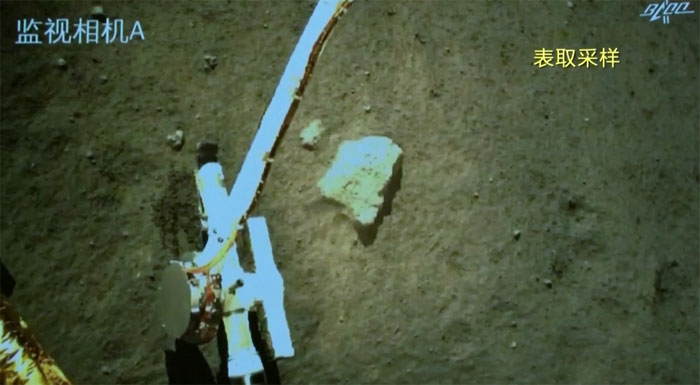The samples collected by the Chang’e 5 mission reveal that volcanic activity on the Moon has lasted nearly a billion years longer than previously thought.
After months of research following the return of the Chang’e 5 lunar probe from China to Earth with 2 kg of lunar soil samples late last year, geologists have made several significant discoveries about Earth’s only natural satellite.
In a report published in the journal Nature in October, a research team from the Institute of Geochemistry and Geophysics (IGG) under the Chinese Academy of Sciences (CAS) stated that they have identified the youngest volcanic rock sample on the Moon, approximately 2 billion years old, extending the “lifespan” of lunar volcanism by an additional 800 to 900 million years compared to previous estimates.
Before Chang’e 5, the last successful return of lunar rock samples to Earth occurred four decades ago during NASA’s Apollo 17 mission. Subsequent analysis of those samples revealed that the youngest volcanic rock—indicative of the Moon’s last volcanic activity—was nearly three billion years old.
“The most obvious difference between the samples from Chang’e 5 and Apollo is their ages. This extends the volcanic activity on the Moon by nearly 1 billion years,” emphasized Professor Ross Mitchell at IGG.
The Chang’e 5 probe collects lunar rock samples and returns them to Earth. (Video: Reuters)
The samples from China were collected in a basaltic region known as Oceanus Procellarum. This area formed during volcanic eruptions billions of years ago, meaning that the surface rocks originally originated from within the Moon in the form of ancient magma.
This new discovery raises more questions. Compared to Earth, the Moon is much smaller and lighter. It lacks an atmosphere and has an almost non-existent magnetic field. How could this celestial body retain heat for such a long time? It should have cooled down much earlier.
The research team suggests that the radioactive elements found within the Moon’s surface layer might be the answer. They have provided significant heat to the Moon, allowing the mantle to melt much more easily. These radioactive elements are collectively known as KREEP, an acronym for a mixture of potassium (K), rare earth elements (REE), and phosphorus (P)—a geochemical component of certain types of lunar rocks.
“From orbital observations, we know that there are many heat-generating elements on the surface of the Moon. But the question is whether there are the same amounts of heat-generating elements in the mantle? Because that’s where the celestial body needs to melt the mantle to create volcanism. The surface rocks are very rich in these heat-generating elements, but as you go down into the mantle, they are quite rare,” Mitchell added.
Another hypothesis is related to water, the source of all life. Scientists suggest that a significant amount of water may have been retained in the Moon’s mantle since ancient times.

Chinese spacecraft conducting sampling on the Moon.
“If you add water to a rock, it usually melts at a much lower temperature than when there is no water in it,” Mitchell explains. “There are some measurements from the Apollo era indicating that the Moon’s mantle has as much water as Earth’s mantle, but there are also other measurements suggesting that some areas are much drier. So what type of rock did Mitchell collect? Wet or dry?”
Analysis shows that the basalt samples from Chang’e 5 have very low moisture content, indicating that the mantle in this area did not contain much water at the time the rock was formed.
So what exactly allows the Moon to retain heat for so long? This remains unanswered by scientists. “That’s the most exciting aspect of the Chang’e 5 mission. When you answer one question, a new question arises,” the professor shared.


















































